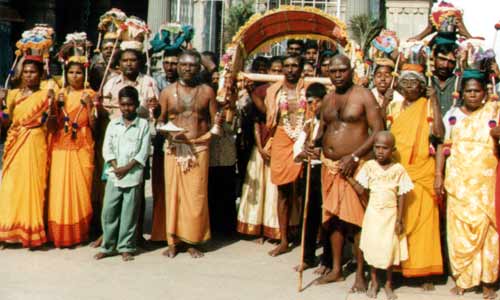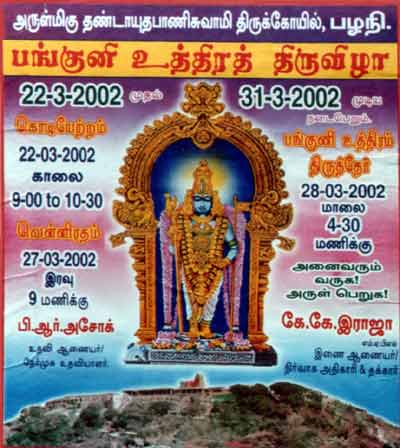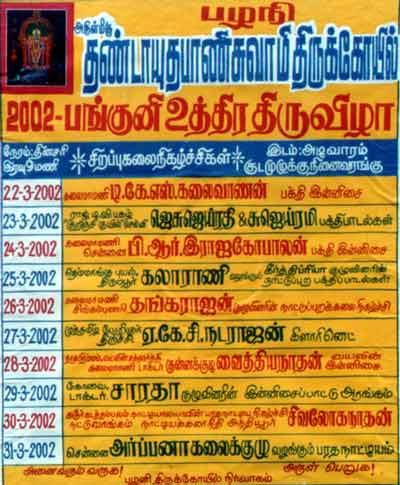
|
||||||||||||
|
| ||||||||||||
Palani: Symbol of Sublime RenunciationThe Lord of Palani is glorified in many ways. K. Venkatachari writes about Muruga's hill abode where Panguni Uthiram is celebrated.
Palani occupies an important place among the six abodes of Lord Muruga referred to as `Arupadaiveedu' and glorified by Nakkeerar in Tirumurugatrupadai. The downhill temple at Tiruvavinankudi and the more popular hill shrine at Palani are significant pilgrim centres thronged by tens of thousands of people of Tamil Nadu and Kerala every day. The main shrine up the hill is said to have been built by a ruler of Kerala called Cheraman Perumal in the seventh century. One can find a carving of the king mounted on horseback in the exterior of the northern wall of the sanctum sanctorum. The Navagraha Mandapam built by the Nayaks is a stone structure with four pillars surrounding the central shrine. The other portions of the temple are attributed to the Pandya and a number of local chieftains. Palani with its hill shrine at an altitude of 1,500 ft. is on the Dindigul-Coimbatore line and is easily accessible connected by bus services from major towns of Tamil Nadu. There are comfortable devasthanam rest houses, choultries and deluxe cottages for the benefit of the pilgrims and tourists.
Worshipped almost by the entire population of Kerala, the Lord faces the west as though to grace them, responding to their prayers. It is common to find parents from Kerala conducting Annaprasanam for their children in Palani. Lord Muruga of Palani in many and varied forms appeals to different grades of humanity. To those who love the tenderness of childhood, he is `Kulandaivelan,' to those who love valour and adventure, he is `Devasenapati,' to the spiritually thirsty, he is `Swaminatha,' to the common householder, he is the consort of Valli and Deivayanai and to the seers and saints, he is `Palaniandavar.' Thus the Lord manifests Himself in myriad forms, blessing all alike, from the baron to the beggar. Deities worshipped in the shrines of Tamil Nadu are usually carved in stone. But the image of Lord Muruga at the hill temple is strikingly different It is an amalgam comprising "Navapashanam" — nine kinds of medicinal minerals (some say it is poisons seven in number blended together in a unique proportion) made by the great mystic — Siddha Bogar. The legendary background of Palani is as follows: Sage Agasthya bade his disciple Idumban to carry two hills, Sivagiri and Saktigiri, to his hermitage. Idumba lifted the hills, slung them across his shoulders and started his journey. The form came to be called `Kavadi' by the common man. Overcome with fatigue, Idumba had to break his journey at Palani to replenish his energy and strength. As Idumba resumed the journey, he found it impossible to lift the hills; so firmly were they entrenched. Understanding that it was Lord Muruga who made the hills immovable, Iduma challenged Him for a duel but was routed out and killed. But the gracious Lord resurrected Idumba and made him his sentinel at the entrance! Thus came up the shrine of Idumba, half the way up the hill. Since then the custom of bringing offerings to Lord Muruga in the form of a kavadi by his devotees came into vogue. There is also another legendary representation as to how Lord Muruga came upon the hill, making it His dwelling, and how the hill derived its name. Sage Narada offered a fruit to Lord Siva which became the bone of contention between Muruga and Ganapati. Outwitting Muruga in a contest, Ganapati got it. The disappointed child sought shelter in the hills on the earth, far removed from the home of heaven. Lord Siva himself hastened to the hills of Palani and tried to pacify his son with the theory that Muruga was the fruit of all wisdom and knowledge (Pazham Nee). But the divine child little relented and preferred to settle as a recluse in peace and solitude. Lord Muruga holding a staff in his right hand with his left hand placed on the hip is fittingly adored as `Dandayudhapani.' Divested of all adornments with a slender cloth around His loin the deity is aptly worshipped as `Pazhani Andi,' reverentially called `Palani Āndavar'. The Lord is the very embodiment of Sublime Renunciation. There are held five pujas or services every day. At 5 a.m. the Lord offers Viswarupa Darshan. The first puja is vizha puja or day's festival at 7.15 am followed by kala sandhi at 8 a.m., sirukala sandhi at 9 a.m., uchi kalam (midday service), saya raksha (evening service) and Raak kalam (night service). Each service consists of three rituals — abhishekam (anointment), prasadam (offering of food) and 3) alankaram (decoration). Anointment for the deitiesAnointment for the presiding deity made of `Nava Bhashanam' takes place during the `Kala Pujas' only. Anointment for the deity made of copper is done for the benefit of the devotees to fulfil their vows and desires. This is know as `Ubaya Abhishekam'. At Palani, the Lord's apparel is changed many a time in a day. The deity is attired and decorated much like a prince, hunter and ascetic. It is a visual delight more to be experienced than expressed. Bhogar was a universally revered alchemist-mystic (siddha) and physician believed to have lived around 3,000 B.C. He travelled widely along the near east and the far-east disseminating knowledge and wisdom among the common mass. His mortal remains are enshrined in a niche in the southwest corridor of the temple. The image of Navadurga and the Maragadha Sivalingam are also installed here. An underground passage is said to connect the Bhogar shrine and the sanctum sanctorum of Palani Āndavar. © 2000 - 2004 The Hindu of 02 April 2004
|


